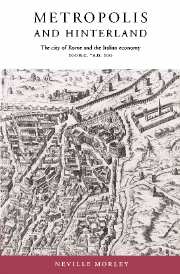Book contents
- Frontmatter
- Contents
- List of maps and figures
- Preface
- List of abbreviations
- Introduction: Rome and Italy
- 1 The metropolitan city in a pre-industrial economy
- 2 The demographic burden
- 3 A model of agricultural change
- 4 The transformation of the Roman suburbium
- 5 Agricultural development in central Italy
- 6 Exploiting the margins
- 7 Marketing and urbanisation
- Conclusion
- Bibliography
- Index
5 - Agricultural development in central Italy
Published online by Cambridge University Press: 17 August 2009
- Frontmatter
- Contents
- List of maps and figures
- Preface
- List of abbreviations
- Introduction: Rome and Italy
- 1 The metropolitan city in a pre-industrial economy
- 2 The demographic burden
- 3 A model of agricultural change
- 4 The transformation of the Roman suburbium
- 5 Agricultural development in central Italy
- 6 Exploiting the margins
- 7 Marketing and urbanisation
- Conclusion
- Bibliography
- Index
Summary
Beyond a certain distance from the market it is no longer profitable or practical to specialise in exotic, perishable foodstuffs; farms outside the immediate hinterland of the city will tend to grow the standard mixture of cereals, vines and olives. However, according to our model it is likely that many farmers in the succeeding zone will still alter their methods of cultivation in response to the demands of the market. Within a region extending up the Tiber Valley and along the Tyrrhenian coast, the price of land – at any rate the price of the most fertile land, and of land with good access to transport arteries – will be high enough to persuade farmers to intensify production, whether by increasing inputs of land, capital and labour, by introducing improved technology and techniques or by making changes in the organisation of labour.
Our most important literary sources for the development of agriculture in central Italy are once again the works of the Roman agronomists. Invaluable though these writings are, a number of problems should be noted. The treatises contain a mixture of description and prescription, and in many cases it is impossible to say how far the advice may have been followed by farmers. The way in which the agronomists illustrate their precepts with anecdotes and examples, and above all their clear awareness of the innumerable different situations which may be encountered in the field, suggest that their works are not merely theoretical or rhetorical exercises, but this may still be farming as practised by an enthusiast with the income to support his hobby.
- Type
- Chapter
- Information
- Metropolis and HinterlandThe City of Rome and the Italian Economy, 200 BC–AD 200, pp. 108 - 142Publisher: Cambridge University PressPrint publication year: 1996

